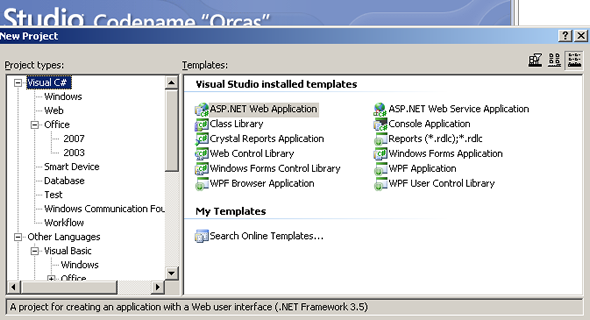Introduction
A while ago I published an article on .NET 3.0 WPF Tools && Examples and another one on .NET 3.5 Integrated Query Language (LINQ). I don't know if anyone looked at those.
But anyway, what is of interest is that these 2 articles all used pre-released CTP editions of tools such as Cider" - The Visual Studio Designer for WPF, and the actual May 2006 LINQ CTP for LINQ development.
Which is all well and good, but don't we really want to use all these new technologies such as WPF/WCF/WWF/Cardspace/ LINQ/DLINQ/XLINQ in a single all encompassing IDE ?
If your answer to this question was yes (which it should be), then you will probably be interested in the new Visual Studio Code Name "Orcas" - March 2007 Community Technology Preview (CTP). I have just downloaded this (its about 4GB, but I was curious) and would just like to share some screen shots with you lot, just so you can see what you will be getting (providing it doesn't change too much) when this version of Visual Studio is released.
So without further ado, let's look at some screen shots.
Visual Studio "Orcas" Preview Screen Shots
Main Project Types
Main Projects (I use C#, I'm sure it's the same for VB)

It can be seen that there are a few new project templates here for dealing with WPF.
Office Templates

Another Window shows that there is now Office templates. So it looks like we can now write true .NET Office apps. Or will this still use Interop ???
Winforms Application
Creating a new Windows Forms Application is much the same as Visual Studio 2005. With the exception of that we now get a nice WPF_Interoperability ElementHost control. Nice.

Windows Presentation Foundation (WPF)
Creating a new Windows Presentation Foundation Application is easily done by the new project template which will create the boiler plate code for creating a new Windows Presentation Foundation Application. What is also nice is that all the XAML controls can now be dragged straight onto the current document. This is basically replacing the current Visual Studio 2005 XAML add-in "Cider" - The Visual Studio Designer for WPF where the developer may switch between Design / XAML code.


Windows Communication Foundation (WCF)
Creating a new Windows Communication Foundation Application is easily done by the new project template which will create the boiler plate code for creating a new Windows Communication Foundation Application.


Windows Workflow Foundation (WWF)
Creating a new Windows Workflow Foundation Application is easily done by the new project template which will create the boiler plate code for creating a new Windows Workflow Foundation Application. This is basically replacing the current Visual Studio 2005 Workflow add-in Visual Studio 2005 extensions for .NET Framework 3.0 (Windows Workflow Foundation).


It can be seen that the developer can drag and drop workflow elements straight from the toolbox.

LINQ/DLINQ/XLINQ
Currently the new Language Integrated Query extensions to Visual Studio are available as a standalone CTP (The May 2006 LINQ CTP) though, apparently these names will be changed in the new version of Visual Studio "Orcas"
- LINQ will be renamed -> LINQ to Objects
- DLINQ will be renamed -> LINQ to SQL
- XLINQ will be renamed -> LINQ to XML
I am also in the process of writing 3 articles on these, which are available here if you are interested.
But anyway let's have a look at what we get with Visual Studio "Orcas".
Well there is actually a LINQ to SQL designer (in the March 2006 CTP this is currently called the DLINQ designer) that can be used to specify the database entities. Think of these as tables. This could of course also be done through code, if like me, you don't like designers.

It can also be seen that for one of these entity (table) classes we can either let the designer automatically create the INSERT, UPDATE and DELETE commands for us. Or we could specify our own custom logic, StoredProcedures for example. I am going to cover this in my next LINQ article (part 2 of 3, part 1 is available here. If you like this, you may also like that one).
The LINQ to SQL designer will produce the required code to allow the database entities to be queried, as shown below.

Web Project (ASP.NET)
To me it looks like a Web project now uses the standard ASP.NET 2.0 stuff, along with some of the better CSS Editing that is available within the Expression Web Designer Beta
Anyway it looks like this when you try and add new styles. The toolbox is largely the same as Visual Studio 2005.

Other Items That May Be Added To A Project
What other items can we add to a project (I use C#, I'm sure it's the same for VB).


The items that are circled appear to be the new item types that should be of particular interest.
Conclusion
Obviously this article has no ground breaking content here, its just showing you good folk what the new Visual Studio may look like. It's more about curiosity than anything else.
It does however look like the next version of Visual Studio will actually bring all these .NET 3.0 (WPF/WCF/WWF Cardspace) / .NET 3.5 (LINQ/DLINQ/XLINQ) together in one usable IDE which can only be a good thing IMHO.
History
- v1.0 30/03/07: Initial issue
